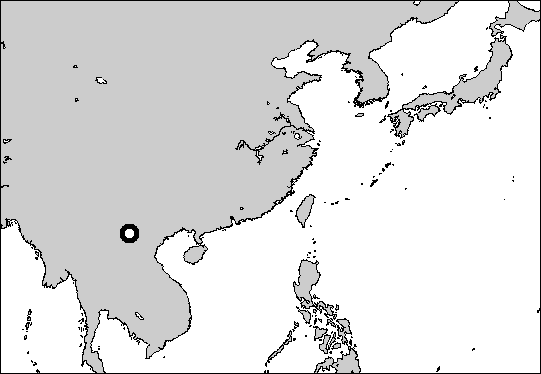
| www.CuriousTaxonomy.net |
|
The Flood in World Myth and Folklore
East Asia |
| © 2021 Mark Isaak |

A brother and sister tried to dig out a bamboo rat, but it told them it was digging to escape a coming flood and instructed them to seal themselves inside a drum to save themselves. They did so. Some richer people took refuge on rafts, but the rafts overturned when the waters receded, and those people died. The brother and sister made a hole, saw water, sealed the drum again, and waited longer. The second time they made a hole, they saw dry land and emerged. (In another version, they took along a needle and knew the flood was over when no water leaked in the hole they poked.) They looked far and wide for mates, but they were the only survivors. A malcoha cuckoo sang to them, "brother and sister should embrace one another." They slept together. After seven years, the child was born as a gourd. They put it behind their house and went about their work. Later, hearing noises from the gourd, they burnt a hole in its shell, and people of the different races came out, first Rumeet, then Kammu, Thai, Westerner, and Chinese. The Rumeet are darker because they rubbed off charcoal around the hole. At first, none of those people could speak. They sat down in a row on a tree trunk, it broke, and they all cried out, and with that they were able to speak. Later, the different people all learned different ways of writing.
Lindell, Kristina, Jan-Ojvind Swahn, & Damrong Tayanin, 1976, "The Flood: Three Northern Kammu Versions of the Story of Creation", in Dundes, 1988, 268-278.

A young brother and sister, orphaned and poor, went hunting in the forest one day and saw a bamboo rat. They chased it into a hole and soon dug it out. The rat begged for its life and offered, in exchange, to tell them how to survive a great rain that would soon flood the entire world. The children released the rat, and it said to them: "Prepare a hollow log and stock it with food and water for seven days and nights. Go inside and seal the ends with beeswax. After seven days, pierce the wax with a porcupine quill; if no water leaks in, it will be safe to exit."
The rain came; the seas and rivers overflowed. The children had done as the rat advised and emerged from the log after seven days. The log had settled on an oleaster tree, which is why the tree is crooked even to this day. The children separated and went in different directions looking for survivors, but they found none. After long searching, they met each other again and, dispirited and desperate, sat down and cried. A _tgook_ bird advised them to marry in order to give birth to humankind. They did so, and the wife soon became pregnant. Seven years, seven months, and seven days later, she gave birth to a gourd. The husband wanted to smash it, but the woman stopped him and placed it in the smoking-rack above the cooking fire.
Returning home from their field one day, the couple heard laughing coming from their house, which fell silent when they entered. The husband placed his ear to the gourd and heard noises coming from it. Fearing her children inside could be hurt by cutting the gourd open, the wife told her husband to prick a hole in it with a burnt stick instead. First the Xa (Khmu) came out. The husband enlarged the hole and the Thai, the Lao, and the Lue came in turn. The wife took the stick and cut the gourd open, and the Vietnamese and Chinese came out. The Xa were soot-covered, so their skin is black. The Thai, Lao, and Lue were less sooty, so they are not as dark. The Vietnamese and Chinese were not soot-covered, so their skin is white.
Dang Nghiem Van, 1993, 305.
